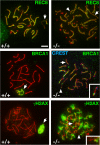SYCE2 is required for synaptonemal complex assembly, double strand break repair, and homologous recombination
- PMID: 17339376
- PMCID: PMC2064047
- DOI: 10.1083/jcb.200610027
SYCE2 is required for synaptonemal complex assembly, double strand break repair, and homologous recombination
Abstract
Synapsis is the process by which paired chromosome homologues closely associate in meiosis before crossover. In the synaptonemal complex (SC), axial elements of each homologue connect through molecules of SYCP1 to the central element, which contains the proteins SYCE1 and -2. We have derived mice lacking SYCE2 protein, producing males and females in which meiotic chromosomes align and axes form but do not synapse. Sex chromosomes are unaligned, not forming a sex body. Additionally, markers of DNA breakage and repair are retained on the axes, and crossover is impaired, culminating in both males and females failing to produce gametes. We show that SC formation can initiate at sites of SYCE1/SYCP1 localization but that these points of initiation cannot be extended in the absence of SYCE2. SC assembly is thus dependent on SYCP1, SYCE1, and SYCE2. We provide a model to explain this based on protein-protein interactions.
Figures





References
-
- Ashley, T., C. Westphal, A. Plug-de Maggio, and D.G. de Rooij. 2004. The mammalian mid-pachytene checkpoint: meiotic arrest in spermatocytes with a mutation in Atm alone or in combination with a Trp53 (p53) or Cdkn1a (p21/cip1) mutation. Cytogenet. Genome Res. 107:256–262. - PubMed
-
- Bergerat, A., B. de Massy, D. Gadelle, P.C. Varoutas, A. Nicolas, and P. Forterre. 1997. An atypical topoisomerase II from Archaea with implications for meiotic recombination. Nature. 386:414–417. - PubMed
-
- Chen, W.V., and P. Soriano. 2003. Gene trap mutagenesis in embryonic stem cells. Methods Enzymol. 365:367–386. - PubMed
-
- Chen, W.V., J. Delrow, P.D. Corrin, J.P. Frazier, and P. Soriano. 2004. Identification and validation of PDGF transcriptional targets by microarray-coupled gene-trap mutagenesis. Nat. Genet. 36:304–312. - PubMed
-
- Costa, Y., R. Speed, R. Ollinger, M. Alsheimer, C.A. Semple, P. Gautier, K. Maratou, I. Novak, C. Hoog, R. Benavente, and H.J. Cooke. 2005. Two novel proteins recruited by synaptonemal complex protein 1 (SYCP1) are at the centre of meiosis. J. Cell Sci. 118:2755–2762. - PubMed
Publication types
MeSH terms
Substances
Grants and funding
LinkOut - more resources
Full Text Sources
Molecular Biology Databases

